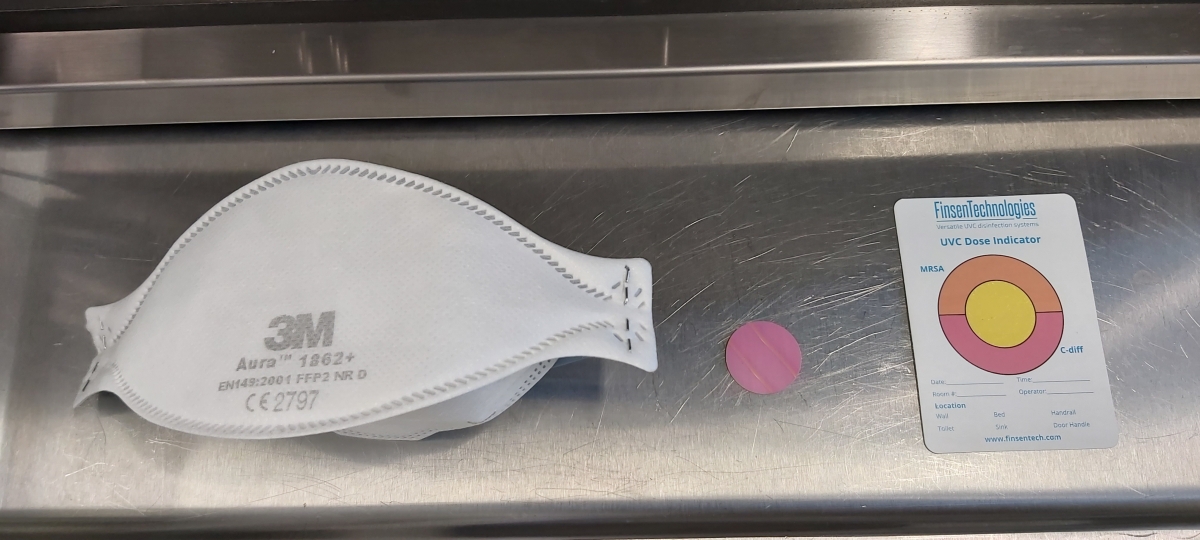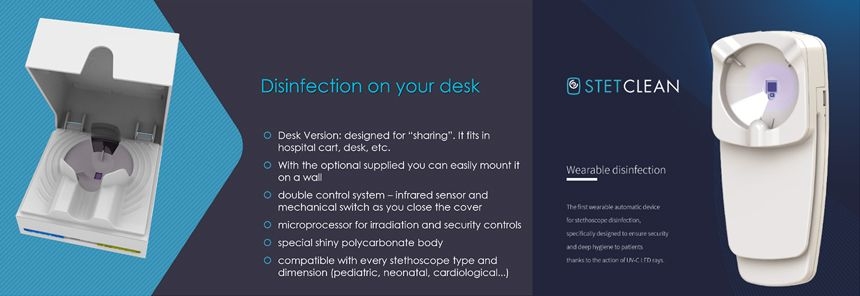
It is not easy for us to work pro-actively and propose solutions that can help improve the current conditions in the health sector without running the risk of appear as those who in these hours are speculating on a situation that, especially in Italy, is particularly serious. We know, however, that the difficult containment of this pandemic will hit all the countries, sooner or later, and anybody will have to face the same problems. Furthermore, this kind of dangerous conditions are not unique, and they will presumably reoccur cyclically in the future.
We believe that sharing information on the solutions implemented around the world using Light Progress products would be useful, especially as many of our systems can safeguard people's health and enable healthcare professionists to work much more safely.
UV – C EFFICACY AGAINST CORONA VIRUSES (SARS – MERS)
Our company has always been committed to preventing contamination and increasing safety by controlling cross transmissions in all areas: surface treatment, air quality and water purification.UVGI is an established and reliable technology, but a solid know-how is required for effective and safe use. UVGI uses ultraviolet light to inactivate microorganisms, mainly by cross-linking thymidine nucleotides in DNA and uracil nucleotides in RNA, which block replication. UVGI systems are relatively fast and easy to use, leave no chemical residues and do not expose workers to harmful substances.
At this time there are no specific tests available on UV resistance of the Coronavirus SARS-Cov-2, but there are examples of scientific literature about the UV-C treatment of very similar viruses, such as SARS or MERS.
There is also evidence of the effectiveness of ultraviolet rays in disinfecting air and surfaces from microorganisms that are much more complex and difficult to treat than this virus in healthcare environments, such as C. Difficile, MRSA, or even more deadly threats such as Ebola and Legionella. (Kowalski 2009)
It is estimated that the SARS-CoV-2 virus can survive on surfaces for up to nine days, based on its similarity to SARS and MERS.
Standard disinfectants are effective against SARS-CoV-2, but to provide additional protection and defend against errors in the manual disinfection process, UVGI can be used to disinfect surfaces and equipment following manual chemical disinfection.
“ASHRAE” (American Society of Heating, Refrigerating and Air-Conditioning Engineers) recommends ultraviolet germicidal irradiation as a way to address disease transmission on COVID-19.
Use of UV irradiation in air conditioning and air treatment systems has also been recommended for many years.
Light Progress UV systems for air conditioning are already widely used in many sectors: hospitals, industry, transport networks and residential centers. For more information, see the HVAC section of our website
SANITIZE MASKS WITH UVGI
UVGI has been successfully tested in laboratories as a way to decontaminate N95 masks exposed to MS2 bacteriophage and influenza virus.
In recent weeks our distribution network in the healthcare sector is working non-stop. Our partners are professionals and experts in Infection Control, and they provided us with numerous application ideas, which can – or indeed, must - be shared as much as possible.
Lights4Health, our partner in the Netherlands, has just provided the SEH department (First Aid) at Leiden University Medical Center with UV treatment cabinets. The systems will disinfect N65 masks in use by medical and paramedical staff.
Two studies on the UV-C treatment of the masks were published in leading scientific journals in 2015 and 2018, respectively, well before the recent release of Covid-19.
- National Institutes of Health: Effects of Ultraviolet Germicidal Irradiation (UVGI) on N95 Respirator Filtration Performance and Structural Integrity
- American Journal of Infection Control: Ultraviolet germicidal irradiation of influenza-contaminated N95 filtering facepiece respirators
“The possibility of a global pandemic of an infectious respiratory disease is of tremendous concern to the occupational health community, because healthcare workers would face the greatest risk of exposure.
For pandemic diseases that may be transmitted by airborne particles, the isolation precaution guidelines from the Centers for Disease Control and Prevention (CDC) call for healthcare workers to wear respiratory protection while treating patients. Because of their loose fit and low filtration capacity, surgical masks do not provide respiratory protection from small airborne particles.
For this reason, the most common respiratory protection device used in healthcare settings is the disposable N95 filtering face-piece respirator (FFR). However, infection control procedures typically call for disposable FFRs to be discarded after a single use to avoid cross-contamination.
This means that a pandemic of a disease such as influenza would require a tremendous number of FFRs to protect healthcare workers from airborne transmission. The Institute of Medicine (IOM) projected that a 6-week influenza pandemic would require 90 million FFRs. The Occupational Safety and Health Administration (OSHA) has predicted that an influenza pandemic would likely last 24 weeks, which suggests that up to 360 million FFRs could be needed in the United States alone.
A surge in demand of this magnitude would greatly exceed current stockpiles and production capabilities, and would almost certainly result in a shortage.”
One way to meet the growing need for masks during a pandemic would be to reuse them, as even a small number of reuses of each mask would greatly expand the available stock of disposable respirators. During the 2009 H1N1 pandemic, the CDC (“Centers for Disease Control and Prevention” USA) recommended that healthcare facilities consider extending the use and reuse of N95 respirators in cases of extreme need. Buying masks in bulk quantities represents a significant cost, in addition to the difficulties associated with production and distribution processes.
However, a significant concern for reuse is the possibility that the external surfaces of the respirator may become contaminated with infectious material and lead to disease transmission. To avoid this risk, masks should be decontaminated after each use.
Several techniques have been tested for the decontamination of N95 FFR. These include autoclaves, steam generated by heat or microwaves, ethylene oxide, vaporized hydrogen peroxide and bleach. All the methods described have advantages and disadvantages. Heat and steam, for example, may dissolve or degrade the respirator and require the device to dry after treatment.
Chemical disinfectants require rinsing and drying and may leave an unpleasant odor or residue that irritates the skin. Gaseous systems using ethylene oxide or vaporized hydrogen peroxide require specialized equipment and ventilation controls.
MASKS’ DECONTAMINATION WITH UVGI: RISKS AND OPPORTUNITIES
N95 systems cannot be disinfected with alcohols such as isopropanol, because the alcohols remove the electrostatic charge from the filtration medium and substantially degrade its filtration capacity.An important consideration for all decontamination methods, including UVGI, is the risk that they degrade the respirator material and reduce the ability of the mask to filter out infectious bioaerosols.
Some studies have examined the effects of UVGI on the respirator's appearance, fit, airflow resistance and filtration efficiency after one or three decontamination cycles and found no significant effects. However, the effects of prolonged UVGI exposure after multiple decontamination cycles are not known and it is unclear how much a cumulative dose of UVGI respirators can withstand, what damage will occur at the end or how many times disposable masks can potentially be decontaminated and reused.
This suggests that the upper limit for UVGI exposure during repeated disinfection cycles should be set by physical degradation of the respirator material and not by loss of filtration capacity. For some FFRs models, this could potentially being used as a useful warning: if the respirator material is significantly degraded after UVGI disinfection, the mask should obviously be discarded.
It is advisable - for even more effective action - to subject the mask to dry heating at around 60°C to inactivate potential infectious nuclei trapped within the filter weave as much as possible.
Of course, it would be desirable to have sufficient time and possibilities to quickly design N95 masks specifically for healthcare professionals that can be disinfected even 50 times with UV-C disinfection cycles in less than 60 seconds, however the current situation makes this operation impractical.
UV-BOX AND MORE: LIGHT PROGRESS SOLUTIONS TO SANITIZE MASKS AND TOOLS IN HEALTHCARE
Feedback from our sales network suggests that the applications for UV-BOX for contamination control have proven to be an effective response to treat masks and all material contained in an ambulance under heavy use during the current Covid-19 emergency.Due to the need to transport patients and the short time between calls, Leiden University Medical Center decided to treat potentially contaminated material with our UV system. An indicator that changes color when sufficient UV radiation is achieved to inactivate the surface pathogens was used to confirm the correctness of the treatment.
Besides masks, our UV-BOX can be used for the treatment of any other tool, such as instruments commonly used in any hospital, clinics, ambulances, etc.

Light Progress designed also a specific device for stethoscopes decontamination using innovative UV-C LED, a medical device class I, CE registered at the Ministry of Health, FDA approved.
See more at www.stetclean.com
Light Progress products for health care environments have been always represent a simple solution to protect from exposition to possible contamination.
Everybody should be aware as we are that at this time of absolute global crisis UVGI technology can make the difference in how we control contamination spread, safeguarding patients and workers health.
UVGI technology create no resistance on any microorganisms so we can ensure a constant efficacy and a great effectiveness proven by science.
Many applications are possible and not only in healthcare environments, visit our website for more information.
The COVID-19 emergency requires the commitment of everyone
Light Progress is willing to provide its products at discounted prices to meet the growing demands of the market and provide its contribution at this time of extreme difficulties.Contact Us
Bibliografy:
Lindsley WG, Martin SB Jr, Thewlis RE, et al. Effects of Ultraviolet Germicidal Irradiation (UVGI) on N95 Respirator Filtration Performance and Structural Integrity. J Occup Environ Hyg. 2015;12(8):509–517. doi:10.1080/15459624.2015.1018518
Ultraviolet germicidal irradiation of influenza-contaminated N95 filtering facepiece respirators” Mills, Devin et al. American Journal of Infection Control, Volume 46, Issue 7, e49 - e55
Kowalski, Wladyslaw. (2020). 2020 COVID-19 Coronavirus Ultraviolet Susceptibility. 10.13140/RG.2.2.22803.22566.
Hang L, Yang Y-R, Zhang Z, Lin Z. (2020). Genomic variations of COVID-19 suggest multiple outbreak sources of transmission. medRIX (preprint).
20. Zhu N, Zhang D, Wang W, Li X, Yang B, Song J, Zhao X, Huang B, Shi W, Lu R and others. (2020). “A Novel Coronavirus from Patients with Pneumonia in China”, 2019. N Engl J Med 382,727-733.
Hang L, Yang Y-R, Zhang Z, Lin Z. (2020). “Genomic variations of COVID-19 suggest multiple outbreak sources of transmission.” medRIX (preprint).
Light Progress takes no responsibility in masks degradation using our UVGI systems and all the products must be used consciously.



